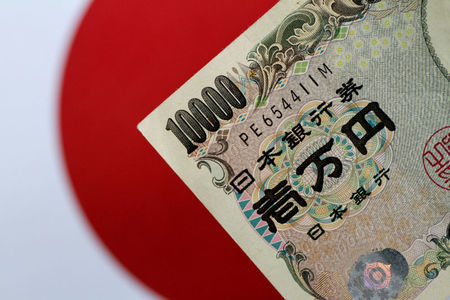Forex
Asia FX firms with Fed on tap; Japanese yen volatile after BOJ

Investing.com– Most Asian currencies rose on Wednesday before more cues on interest rate cuts from the Federal Reserve, while the Japanese yen was volatile following mixed signals from the Bank of Japan.
The Australian dollar was an exception among its regional peers, with the currency sliding to a three-month low after data showed mild easing in core consumer price index inflation- which diminished the prospect of interest rate hikes by the Reserve Bank of Australia.
Yen volatile, USDJPY swings on mixed BOJ signals
The Japanese yen was volatile, with the pair swinging in a range of 0.3% around 0% after the BOJ struck a mixed chord during its meeting.
The central bank hiked its rate by 15 basis points to around 0.25%- the top end of market expectations.
But it also said that it will only halve its pace of Japanese Government Bond purchases- to 3 trillion yen ($19.5 billion) from 6 trillion yen by the first quarter of 2026. The BOJ will reduce its JGB purchases by 400 billion yen each quarter.
BOJ members also lowered their growth and inflation forecasts for fiscal 2024, which sparked uncertainty over just how much headroom the central bank had to tighten policy.
Still, the yen was sitting on strong gains through July as a mix of unwinding carry trade and suspected government intervention sparked buying in the currency.
Dollar dips with Fed, rate cut cues in focus
The and fell 0.2% each in Asian trade, seeing some volatility this week as traders positioned for a Fed later on Wednesday.
The central bank is widely expected to keep rates unchanged. But any signals on plans to cut rates will be closely watched, especially in the wake of some soft inflation readings and dovish comments from Fed officials.
General consensus is for a 25 basis point cut in September, according to .
Focus this week is also on key data, due on Friday.
Australian dollar sinks, AUDUSD as 3-mth low on soft inflation
The Australian dollar was the worst performer in Asia, with the pair sinking 0.5% to its weakest level in three months.
The Aussie’s decline was driven chiefly by some soft CPI data for the June quarter. While overall grew as expected in the quarter, lower drove up hopes that inflation will ease in the coming months, reducing the need for a rate hike by the RBA.
Broader Asian currencies firmed, tracking weakness in the dollar. The Chinese yuan’s pair fell 0.2% as soft data and positive government comments ramped up expectations for more stimulus measures in the country.
The South Korean won’s pair fell 0.3%, while the Singapore dollar’s pair moved sideways.
The Indian rupee’s pair hovered near record highs of 83.8, seeing little relief from a softer dollar.

 Forex3 years ago
Forex3 years agoForex Today: the dollar is gaining strength amid gloomy sentiment at the start of the Fed’s week

 Forex3 years ago
Forex3 years agoUnbiased review of Pocket Option broker

 Forex3 years ago
Forex3 years agoDollar to pound sterling exchange rate today: Pound plummeted to its lowest since 1985

 Forex3 years ago
Forex3 years agoHow is the Australian dollar doing today?

 Cryptocurrency3 years ago
Cryptocurrency3 years agoWhat happened in the crypto market – current events today

 World3 years ago
World3 years agoWhy are modern video games an art form?

 Commodities3 years ago
Commodities3 years agoCopper continues to fall in price on expectations of lower demand in China

 Economy3 years ago
Economy3 years agoCrude oil tankers double in price due to EU anti-Russian sanctions































